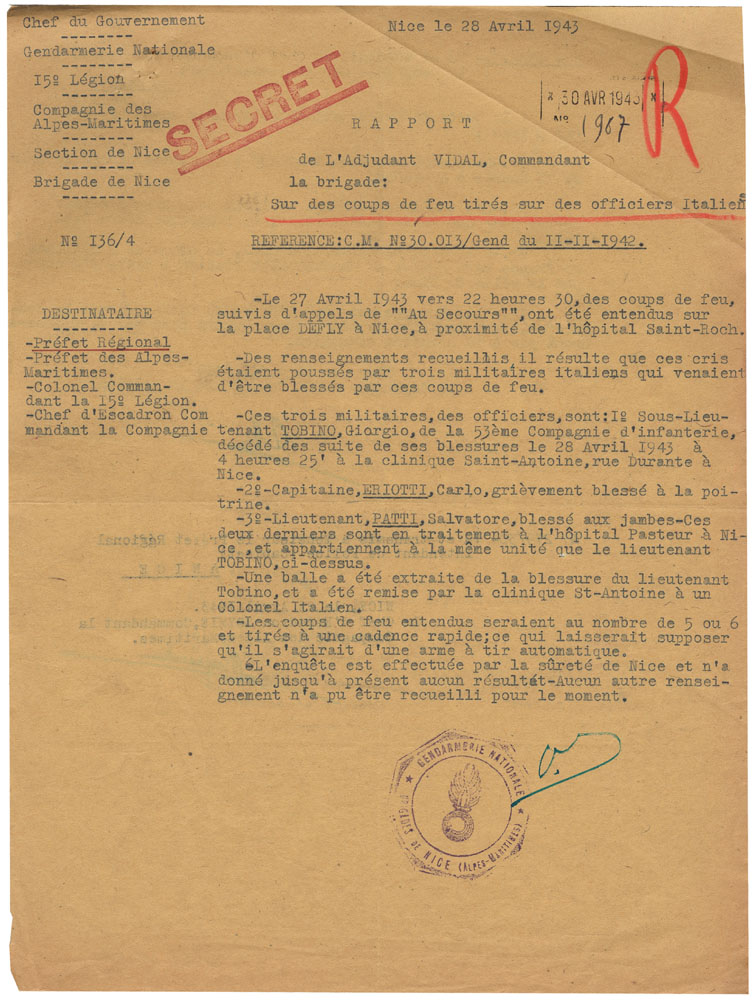Rapport sur l'attentat visant 3 officiers italiens à Nice
Légende :
Rapport de gendarmerie du 28 avril 1943 sur l'attentat commis contre trois officiers italiens du Comando Tappa de Nice dans la nuit du 27 avril (un tué et deux blessés graves) et sur les mesures de représailles édictées par le commandement italien de la Place de Nice
Report on the Attack Targeted Towards Three Italian Officers in Nice
Police report issued on April 28th, 1943 on the attack carried out against three Italian officers of the Comando Tappa of Nice on the night of April 27th (one dead, two seriously injured) and on the retaliation measures enacted by the Italian commander of the city of Nice.
Genre : Image
Type : Rapport
Source : © ADAM 166 W 11 Droits réservés
Détails techniques :
Rapport dactylographié de deux pages (voir verso).
Date document : 28 avril 1943
Lieu : France - Provence-Alpes-Côte-d'Azur - Alpes-Maritimes - Nice
Analyse média
Le rapport apporte des informations relatives aux circonstances de l'attentat (place Defly située entre le mess quitté par les trois officiers et leur hôtel, 22 h 30, cinq ou six coups de feu tirés par des armes automatiques, absence de témoins), à la difficulté de son élucidation (manque d'indices) et à ses répercussions (diverses sanctions visant la Ville de Nice et ordre de faire feu sur ceux qui ne répondraient pas à la première sommation).
The report provides information concerning the circumstances of the attack (place Defly located between the canteen that the officers had just left and their hotel, 10:30 p.m., five or six gunshots fired by automatic arms, no witnesses), the incident’s lack of clarity and evidence, and its repercussions (varying sanctions targeted towards the city of Nice and orders to fire at those who do not obey their first warning).
Jean-Louis Panicacci
Traduction : Sawnie Smith
Contexte historique
De multiples incidents avaient caractérisé les relations entre Azuréens et militaires d'occupation depuis le 11 novembre 1942, des bombes étant lancées dans des casernements d'Antibes (27 février, 12 mars 1943) et de Cagnes-sur-Mer (6 mars) et des coups de feu tirés sur des soldats transalpins à Cannes le 22 avril, sans faire de victimes. L'attentat du 27 avril, vraisemblablement commis par des FTP-MOI, fit donc couler le sang pour la première fois et entraîna des représailles conséquentes pour la Ville de Nice, avec les mesures d'extension du couvre-feu, la fermeture des salles de spectacles (la mesure dura quinze jours) et une amende exemplaire (seule la Ville de Grenoble subira une amende équivalente à la suite de l'attentat meurtrier contre le PC de la division Pusteria le 25 mai), mais aussi l'opération d'épuration conduite le 7 mai, débouchant sur le transfert au camp de concentration de Modane de 226 patriotes. Le passage à la lutte armée se manifestait désormais, éclipsant les sabotages de lignes téléphoniques militaires ou de camions de la IVa Armata.
Beginning on November 11th, 1942, many incidents of this nature set the tone for relations between the locals and the occupying military forces. These incidents included bombs being thrown into the barracks in Antibes (February 27th and March 12th, 1943) and those in Cagnes-sur-Mer (March 6th) and shots fired into groups of Italian soldiers in Cannes the 22nd of April. No victims were claimed. The bombing of April 27th, most likely organized by the FTP-MOI, was the first of these incidents to spill blood. The occupying forces, in response, carried out a series of retaliatory measures: prolongation of the curfew, the closing of performance halls (this lasted fifteen days), and admonitory fines (only the city of Grenoble was subjected to an equivalent fine after a deadly bombing that targeted the headquarters of the Italian Pusteria division, on May 25th). In addition, the occupying forces also began an effort to “cleanse” the population on May 7th with the transfer of 226 French patriots to the concentration camp of Modane. Henceforth, the transition to armed confrontation took precedent, overshadowing other forms of rebellion and insurrection, such as sabotaging the military phone lines and trucks of the IVa Armata.
Auteur : Jean-Louis Panicacci
Jean-Louis Panicacci, L'occupation italienne du Sud-Est de la France, juin 1940-septembre 1943, Rennes, PUR, 2010.
Jean-Louis Panicacci, En territoire occupé. Italiens et Allemands à Nice, 1942-1944, Paris, Vendémiaire, 2012.
Traduction : Sawnie Smith



 Voir le bloc-notes
()
Voir le bloc-notes
()